#visit chiapas
Text
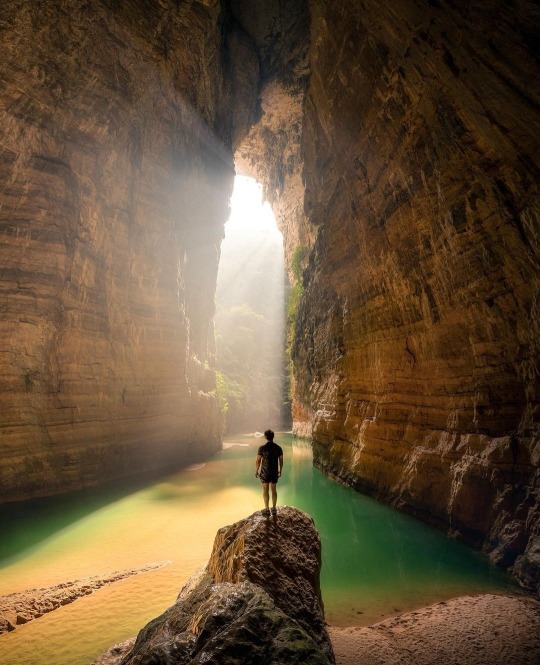
El Arco del Tiempo, Chiapas / Mexico (by Fausto Hernandez).
681 notes
·
View notes
Text

The unfortunate thing about 🎄 Christmas Tree Waterfall in Sumidero Canyon (Mexico) is that it’s best observed in the summer.
“Árbol de Navidad” is a seasonal waterfall, and when it isn’t raining, it sucks. Poor planning on nature’s part if you ask me!
https://www.nextleveloftravel.com/mexico/the-most-beautiful-place-in-mexico-sumidero-canyon-national-park/
0 notes
Text
Chichen Itza is one of Mexico’s top tourist attractions, visited by well over a million people per year. It’s become the most iconic site on the Yucatan Peninsula both because it is the home to remarkable ruins and because it’s close enough to Cancun for a day trip.
For centuries after the city began to decline in importance around the year 1200, the site was forgotten by all but locals. After the Spanish took over Mexico, cattle grazed around the ruins.
John Lloyd Stephens, an American diplomat, visited the site in 1840 and published a book called Incidents of Travel in Central America, Chiapas, and Yucatan. His book fascinated people around the world — Mexico housed ancient ruins that were every bit the equal of those found in Greece or Egypt! Stephens’ detailed illustrations of what he had found in Mexico were spellbinding:

The most iconic building in Chichen Itza is commonly called “El Castillo” (the castle) — but it’s really a temple to Kukulcan, a version of the feathered-serpent god worshipped throughout Mexico at the time.

But this isn’t what the temple looked like in the 1840s when it first caught the attention of the outside world. One of the first images we have of the site is an illustration by Frederick Catherwood, published in 1843:
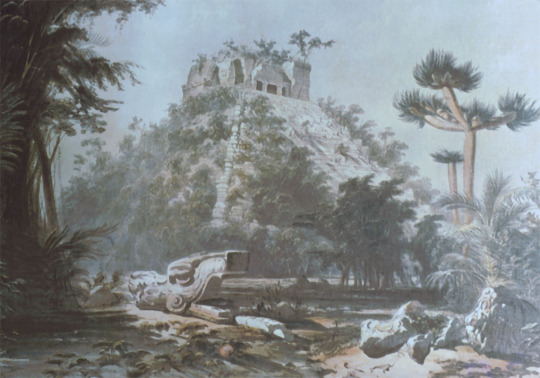
As you might expect in a hot, humid, jungle region, nature had taken over. Though the cattle that grazed around the site had kept the jungle from completely enveloping the site, the buildings were overgrown with vegetation. Not only had the site not been maintained, but as in many ancient sites around the world, people had plundered a lot of the building materials at Chichen Itza to build newer structures.
Many of the early illustrations of Chichen Itza show the buildings in similar condition. Here’s Catherwood’s illustration of a temple that the Spanish had named “the Nunnery:”

{WHF} {Ko-Fi} {Medium}
267 notes
·
View notes
Text
super interesting that in 2019 just before production started on Andor, diego luna visited the EZLN film festival in Chiapas. He's said before that their initial uprising in the 90s was defining moment for him so I would be super curios to know if that visit and that struggle had any impact on the direction of the show, since luna was also executive producer


i dont think the show is like secretly about that or anything but i do have a feeling it had some impact on the decision to change cassian's backstory to originating from a group of people who are clearly meant to be read as indigenous and suffering under extractive industries (that giant open pit mine from episode 3) instead of fest
#i do like that they referenced the old fest thing with the 'fest we told everyone fest' line#andor#fight the empire#star wars#i remember reading somewhere that luna said cassian being kenari was the in-universe reason that he has his actual accent#but i cant find that one
72 notes
·
View notes
Text
Segundo parcial
Estado de Chiapas
Chiapas es uno de los estados más ricos en diversidad y cultura de México. Es cuna de etnias indígenas como los tzotziles, zoques, chamulas, tzeltales y lacandones. El estado de Chiapas cuenta con hermosas ciudades prehispánicas como Palenque y Bonampak, Yaxchilán y Toniná; con un sagrado pasado maya.
La ciudad de las casas de San cristobal.
San Cristóbal de las Casas es una ciudad en la zona alta del estado de Chiapas al sur de México. Es conocida por su arquitectura colonial bien conservada, como la Catedral de San Cristóbal de color amarillo y con siglos de antigüedad ubicada en el Parque Central.
Llavero de fieltro bordados

¿Que es ?
Un llavero de fieltro bordado es un accesorio para llaves hecho de fieltro, un material textil no tejido. Estos llaveros suelen tener diseños bordados en ellos, lo que los hace personalizados y decorativos. Son populares como regalos hechos a mano o como artículos de mercadería.
Material
El material más comúnmente utilizado para bordar sobre fieltro es hilo de bordar de algodón o poliéster. Este tipo de hilo es duradero y viene en una amplia gama de colores, lo que permite crear diseños vibrantes y detallados en el fieltro. Además del hilo, a veces se pueden utilizar otros materiales decorativos como cuentas, lentejuelas o cintas para agregar textura y detalles adicionales a los bordados.
¿para que se utiliza?
Los llaveros de fieltro bordados se utilizan principalmente para mantener organizadas y identificables las llaves. Además de su funcionalidad práctica, también pueden servir como accesorios decorativos o incluso como obsequios personalizados. Algunas personas los coleccionan como recuerdos de lugares visitados o eventos especiales.
¿Quien lo creo ?
La invención y el primer desarrollo de este arte debe atribuirse a los babilonios pues de Mesopotamia procedían los más famosos bordados en la Edad Antigua así como de Egipto los tejidos finos y las tapicerías en lino llegando a decir Plinio que el telar egipcio había vencido a la aguja Babilonia
https://es.m.wikipedia.org/wiki/Bordado#:~:text=La%20invenci%C3%B3n%20y%20el%20primer,vencido%20a%20la%20aguja%20Babilonia.
Second partial
State of Chiapas
Chiapas is one of the richest states in diversity and culture in Mexico. It is the birthplace of indigenous ethnic groups such as the Tzotzils, Zoques, Chamulas, Tzeltales and Lacandones. The state of Chiapas has beautiful pre-Hispanic cities such as Palenque and Bonampak, Yaxchilán and Toniná; with a sacred Mayan past.
The city of houses of San Cristobal.
San Cristóbal de las Casas is a city in the upper area of the state of Chiapas in southern Mexico. It is known for its well-preserved colonial architecture, such as the centuries-old yellow San Cristóbal Cathedral located in Central Park.
Embroidered felt keychain

What is ?
An embroidered felt keychain is a key accessory made of felt, a non-woven textile material. These keychains usually have embroidered designs on them, making them personalized and decorative. They are popular as handmade gifts or merchandise items.
Material
The most commonly used material for embroidering on felt is cotton or polyester embroidery thread. This type of yarn is durable and comes in a wide range of colors, allowing you to create vibrant, detailed designs on the felt. In addition to thread, other decorative materials such as beads, sequins, or ribbons can sometimes be used to add texture and additional detail to embroidery.
what is it for?
Embroidered felt keychains are primarily used to keep keys organized and identifiable. In addition to their practical functionality, they can also serve as decorative accessories or even personalized gifts. Some people collect them as souvenirs of places visited or special events.
Who created it ?
The invention and first development of this art must be attributed to the Babylonians since the most famous embroideries in ancient times came from Mesopotamia, as well as from Egypt the fine fabrics and linen tapestries, Pliny even saying that the Egyptian loom had defeated the babylon needle.
2 notes
·
View notes
Text
Hector "DelONix" Wei - Don in game
(part 1)

I drew some skins (or every, who knows)
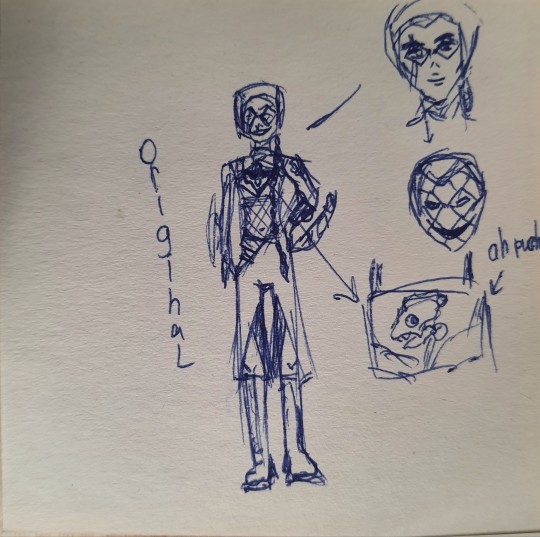
Classic skin - logo on armor changes in rare version from band where he been - los muertos (green), junkertown (blue), vishkar (white), talon (red)... epics maybe be this bands skins with more details on classic skin like neon tattoo for los muertos, torn clothes for junkertown and suit for vishkar
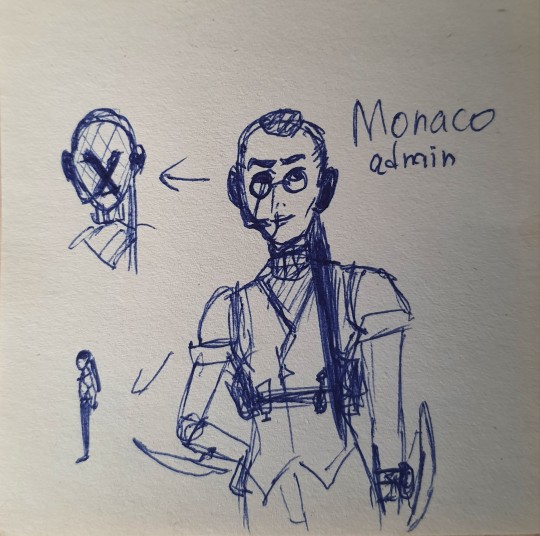
Standart legendary - his work suit from casino monaco
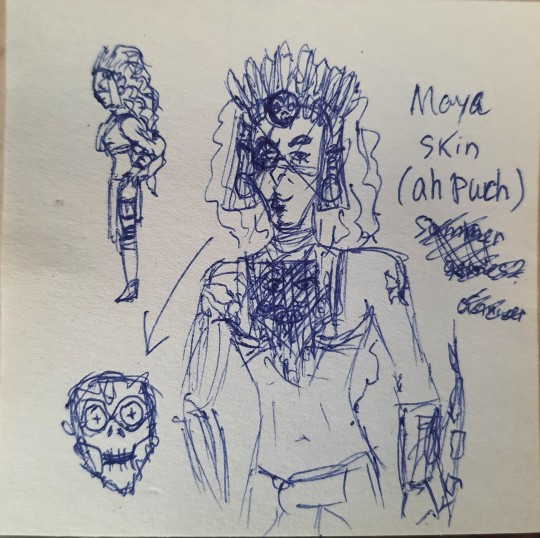
Other standart legendary from his father
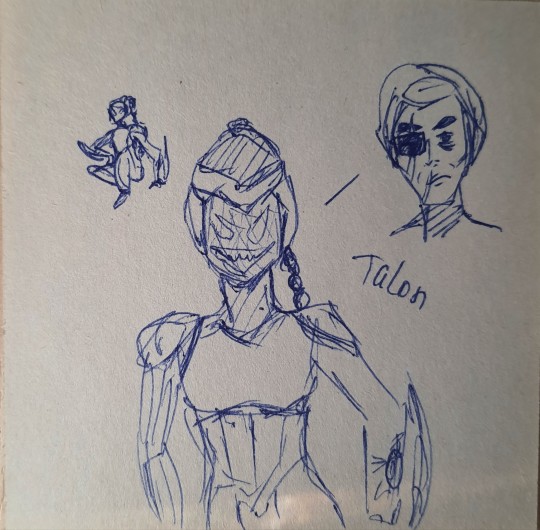
Archives legendary - he first talon assasin or prototype what give talon decision what assasins should be women because find small female easy and they more plastic
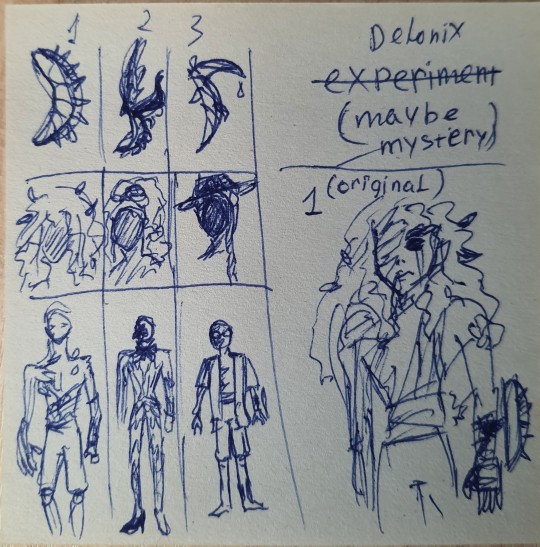
Moira accident when Don loose eye
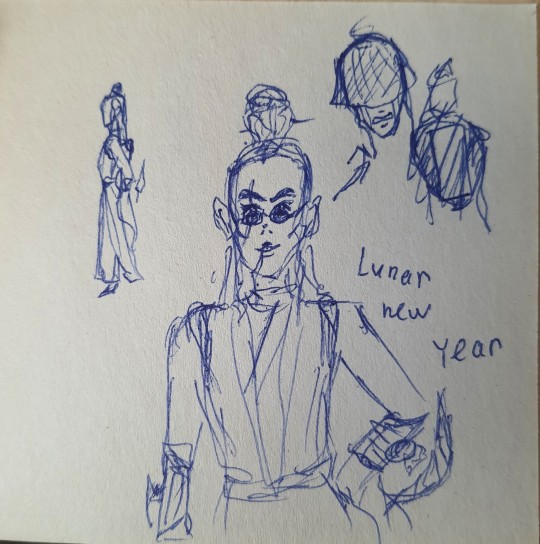

Fancy events
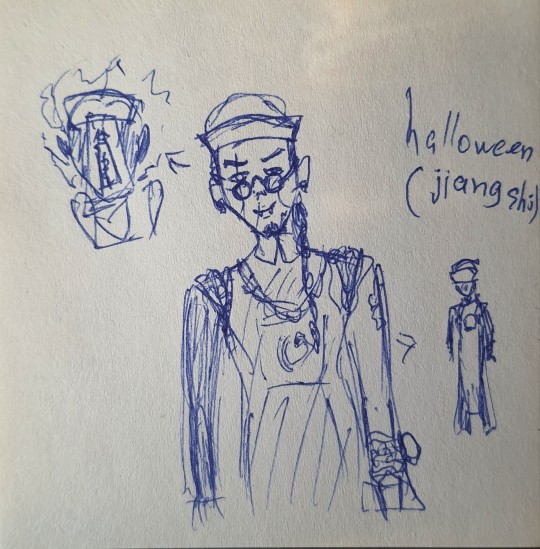
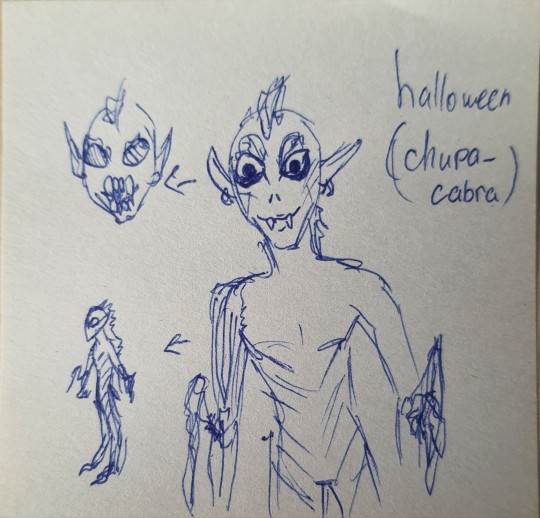
Halloween skins where Don use his parents culture - mom chinese and dad mexican mayan
Lore
Age: 29
Race: race - mestizo (mother is a Chinese archaeologist, father is a Mexican Mayan from Chiapas who kept a private ethnographic museum)
Hector’s parents met in Chiapas when a woman came to help with research on Mayan artifacts and simply loved tourism
I won’t bog you down with lore details because... I would like to make a cinematic (when I learn how to do something like this), but in short, he lost his parents in a fire that the omnics allegedly started, and there he cut off his own hand in order to survive. Las Muertos found him on the ruins of the boy’s house (he was 5), and it was Sombra who contributed to his addition to the “family” and became Hector’s named sister. As a teenager, the head of Muertos sent him to steal something from the Vishkar who visited Dorado for the purpose of improvement, but he was caught and none of Las Muertos began to substitute him (Sombra at that time was already in contact with the Talon and rarely saw him). In Vishkar, they saw potential in the guy with his thieving skills, but no one around him except Niran liked him, and at some point he was sent on a mission to Junkertown to offer to help with the restoration and improvement of the city, which the locals did not appreciate and he ended up in slavery to Queen for a long time. At the age of 27, he was finally saved by Sombra and offered to join Talon, citing the fact that they would give him funds for development and she would help him take revenge on the real murderers of his parents. In the Talon, he became Moira's experiment, which is why he had more mental problems, but at the same time he found a kind of family in the claw, even if in most cases he did not agree with her.
#oc#overwatch#character concept#hector delonix wei#sketch#sombra#junker queen#lifeweaver#talon assasin
2 notes
·
View notes
Photo
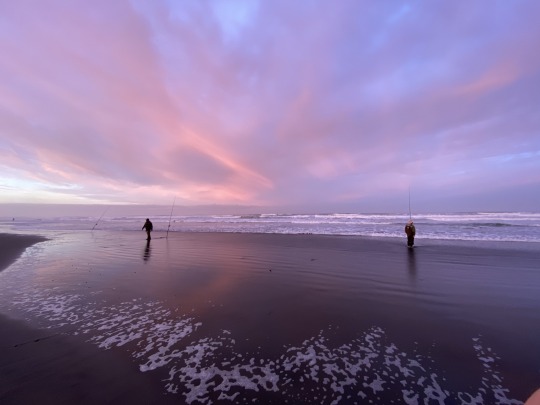
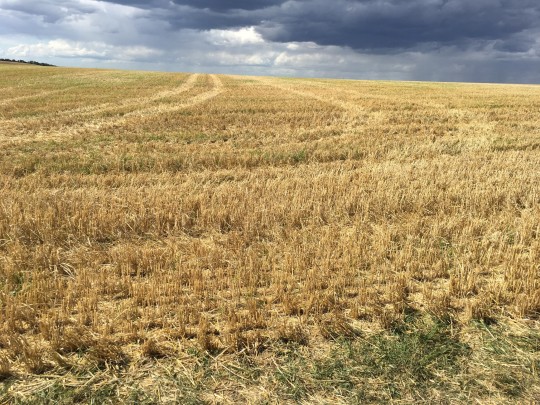
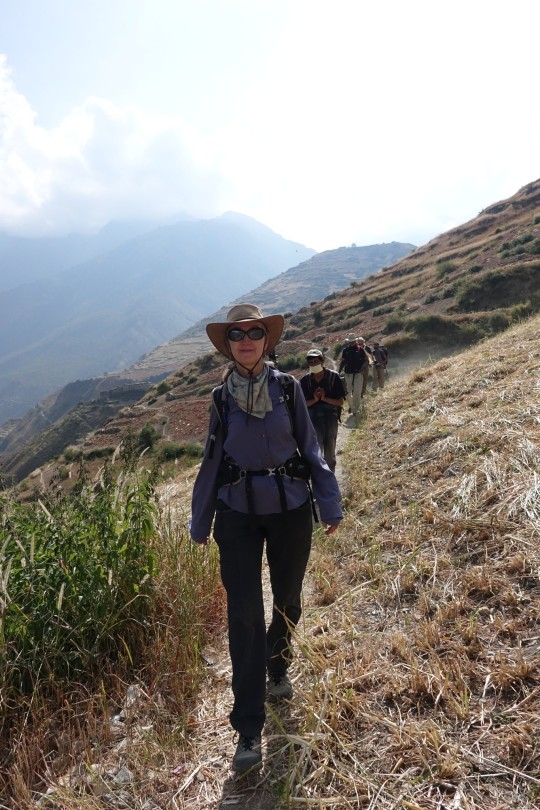
To hell with the New York Times's top 25 commercial/luxurious travel experiences. You can have your own. Here's some of mine, and reflecting on them makes me feel quite replete and not in need of any gourmet well-beaten trails. I hope you have yours.
--travel the pilgrimage trail of St. Jacques de Compostelle from Paris to the Spanish border as a teenage art historian, with the great Mme Francoise Weinman interpreting, 1978.
--bathe in a bathtub on a hillside on Western Shoshone land above matriarchs and federal challengers Mary and Carry Dann's ranch in eastern Nevada while listening to Lucinda Williams for the first time (music courtesy of Lauri Di, who then gave me the homemade cassette), 1991.
--raft trip on assignment for Sierra Magazine, 1995, in a roadless wilderness the size of Portugal in NE British Columbia, where the whole community of wildlife was living its many lives largely undisturbed.
--Dance all night in the streets of Paris, Fete de la Musique, circa 1998, be serenaded by Timothy O'Toole's brother with Marianne Faithful's "Ballad of Lucy Jordan" in parting. (Research for Wanderlust was the official reason to be there.)
--Seattle Nov. 30-Dec. 1, when the protest in the streets galvanized the poor countries to resist the World Trade Organization's bullying on behalf of the rich corporations and countries and the fate of the world took a left turn. "When hope and history rhyme." Thank you David Solnit, who had a lot to do with it.
--Hike with Lucy Lippard to the remote valley whose entrance is framed by two great natural stone slabs on each of which a life-sized cornstalk petroglyph appears; take Barry Lopez to see the life-size bear petroglyph nearby and the giant zig-zag snake petroglyphs, get drenched in a monsoon rain together, New Mexico circa 1999-2001 or so
--Multiple times participating in the Good Friday pilgrimage to Chimayo, NM, circa 1998-2010, witnessing the landscape, the devotion and dedication, the generosity, and the low-rider Cadillac of the stations of the cross.
--find the exact places Eadweard Muybridge, Carleton Watkins, Ansel Adams, and Edward Weston stood to make their iconic pictures of Yosemite with Mark Klett and Byron Wolfe (in what became our book Yosemite in Time), and camp out in the supremely serene jeffrey pine forest south of Mono Lake while working on the project, 2001-4
--repeat visits to New Orleans to first understand the terrible things of Hurricane Katrina and then fall in love with the wonderful culture and dance in various second lines, etc., 2006 onward....
--Zapatista Women's Encuentro, late Dec.-January 1, Chiapas, Mexico, with Marina Sitrin and Sam Sitrin
--Iceland, summer of 2008 (partly melancholy, but studded with epiphanies): "I traveled a little, and on the south coast of Iceland had one magnificent midsummer day that began with a long walk on a path edged with tiny flowers past the largest glacier in Europe, went on to a bay in which the glacier was calving icebergs that were vivid blue in a blue inlet of the sea, and then traversed a long strand of wet sand that reflected the white clouds and blue sky so that heaven and earth were indistinguishable, and the clouds overhead seemed to be almost close enough to touch and those near the horizon seemed to be very near infinity. It was as close to a vision of paradise as I’ve been granted with my eyes open. After that I saw another bay full of hundreds of swans and a steep valley through which dozens of thin waterfalls trickled and poured from the heights. That day ended at a robin’s nest Klara showed me in the low willows in the quiet light at midnight, five small mottled eggs like turquoise stones."
--first visit to David Rumsey's map collection, San Francisco, with David's visionary insight into cartography....-
-two weeks aboard a Swedish vessel circumambulating Svalbard in the high Arctic, 2011
--Arctic National Wildlife Refuge, raft trip, summer solstice, 2014 (also working as a journalist), but also thank you Michael Brune and Dan Ritzman https://www.theguardian.com/.../alaska-wildlife-sanctuary...
--Mt Burdell in green winter splendor, over so many years...
--wake up at Standing Rock to see thousand of joyful people celebrating their determination and solidarity on the great green prairie, 2016 (I went there to report for the Guardian, all too briefly)
--Traveling with Dolpo Tulku rimpoche through Dolpo, the Tibetan plateau/Buddhist land in which he is the spiritual leader, fall 2017, with Roshi Joan Halifax and various others, and doing another version of that route in 2015 that repeats Peter Matthiesson's in The Snow Leopard, including being welcomed into Shey Gompo, and seeing people engaged in daily life on almost medieval terms: plowing with yaks, threshing and reaping and winnowing by hand, traveling on foot or by beast, weaving on wooden looms, tending livestock, crossing high passes up to 17,600' high, spending a month on foot (and occasionally horse)....
--the enchanting walk from the Baldock train station to the cottage Orwell lived in 1936-1940s, through wheat fields full of flints formed undersea and rural rights of way, crossing the ancient Icknield Way (returning to where I first met those roses he planted, if they're his, on Nov. 2, 2017), 2019, walking it again this summer with Rob Macfarlane, 2022
--So many mornings of glorious light at Ocean Beach, because like all of you I also live in the destination.
--camping with my great-nieces who make everything new and exciting again. p.s. Just a reminder: I have had adventures, but my everyday life is staying home quietly turning words around and trying to make meaning with them.
[Rebecca Solnit ]
23 notes
·
View notes
Note
for the new year ask: 22, 23 & 25
Hola, Clau (◍•ᴗ•◍)/ Espero que este último mes del año te esté tratando bonito.
22. Favorite place you visited this year?
My grandma's house in Chiapas. It's always nice to come to the ranch and spend time with my family, especially my cousins.
23. If you could send a message to yourself back on the first day of the year, what would it be?
Even if you don't see it, therapy is paying off. You'll begin to do what you have wanted to do for a long time, and although you may despair of not succeeding or being good at it the first time, at least you are giving yourself the opportunity to try.
Enjoy learning, you'll also meet new people in the process
25. Did you create any characters (in games, art, or writing) this year? Describe one
Yeap.
This year I had the idea of creating a fanchild for Jolymes (if Clamp created Jouta I can give my faves a kid too xP), which has been lot of fun.
Her name is Joselyn, I still figuring out what stand ability she'll have and if it is gonna be a humanoid or object stand (like boingo's manga). I wanted to use Hysteria by MUSE as inspo bc is one of my favorite songs, but I think I'll have to discard that option.
Here are some facts about her:
Truth be told, she's an unplanned baby resulting from a night of drunkenness
Giorno is her godfather because...
I love giorno and I like to play with how his relationship with the rest of the joestar family would be
I couldn't pass up the "godfather" opportunity xP
He was partly the one who conceived Joselyn. Not in that way! More like "accidentally used Golden Experience to create a baby" way
She got used to wearing complicated braids with ribbons bc her moms always did her hair in nice looking styles when she was little.
Keeps both of her moms surnames :3
Besides English, she speaks Spanish thanks to Ermes, thus when she spends time with her godfather she kinda understands some Italian words
Jolyne more than once used stone free's ability to create a child harness to keep an eye on her when the three of them went out.
When she was little, one of her favorite games was jumping rope with Jolyne
Ermes tends to overprotect her a little more than Jolyne. Low-key she's "becoming" Gloria x3
She's aroace
3 notes
·
View notes
Text
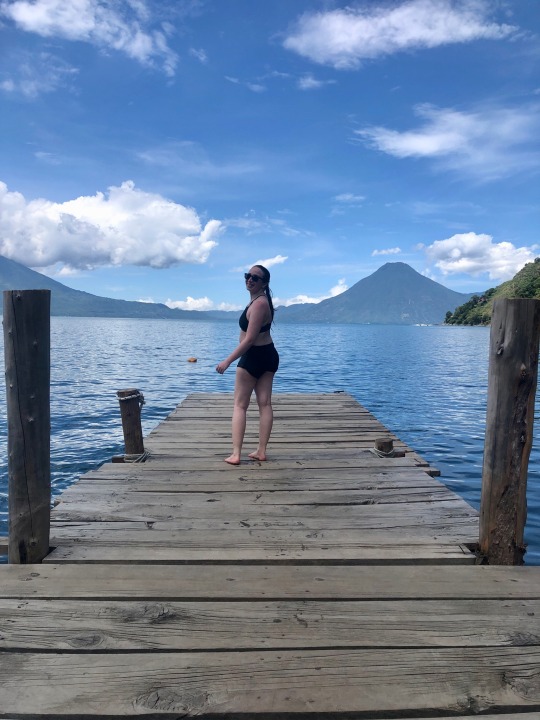


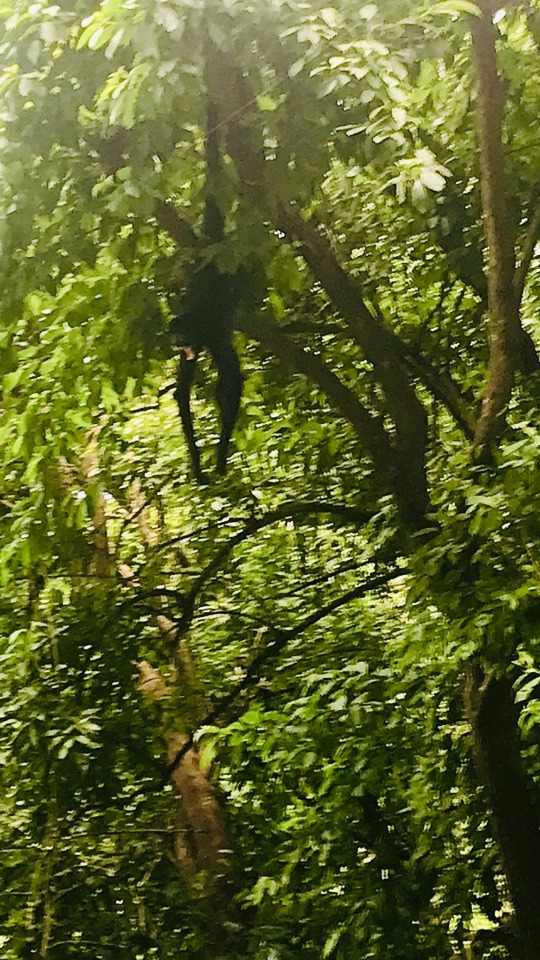

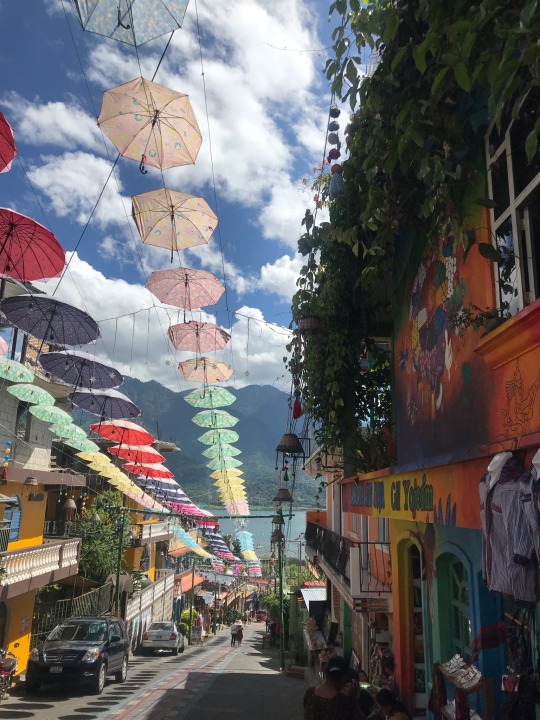
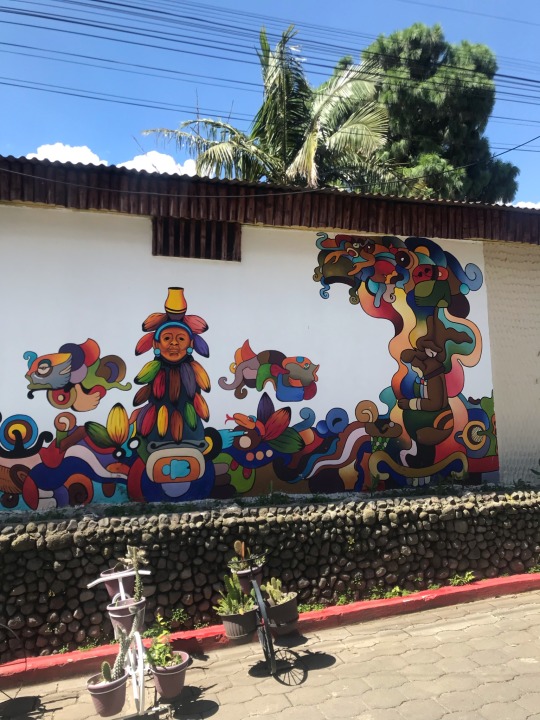


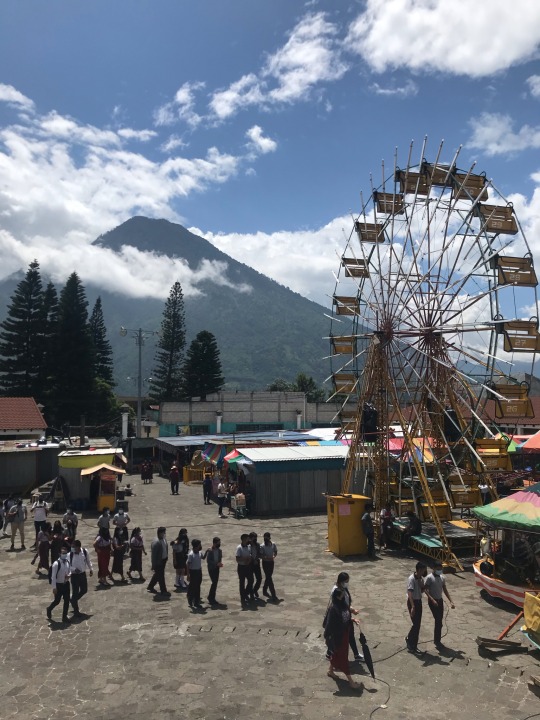
Guatemala Days 7-11
Lake Atitlan
The last 4 days have been spent at Lake Atitlan in the town of Panajachel. On Saturday Emily arrived to Antigua and to our surprise we got upgraded to a deluxe suite which was very fancy.
The next morning we took a shuttle to Panajachel, one of at least 11 towns on the shore of Lake Atitlan. Lake Atitlan is an enormous lake formed from a volcanic crater that is thousands of meters deep. There are at least 3 separate languages spoken by the indigenous people in the surrounding area, that’s how big around the lake is.
On Monday we explored the Atitlan Nature Reserve which was really cool. We hiked to the lakeshore, went across suspension bridges through the jungle, and saw spider monkeys and coatís (a central american variety of raccoons which only live in high altitude jungles).
On Tuesday we did a tour of three different towns along the lake. We got to the different towns by boat. First we went to San Juan La Laguna which had a lot of fair trade textile co-ops. This has helped combat a lot of social problems such as poverty and lack of education access, and has helped elevate indigenous women of the area. Several families team together to weave and form the co-op and whatever the co-op sells the profits are divided equally amongst themselves. A requirement for entering the co-op is enrolling children in school. We visited one of these co-ops and learned more about the weaving process which is incredibly complex. It take between 3 weeks to 3 months to weave a single garment. Unfortunately a lot of factory made copycat products are sold on the street for less than a 10th of what it costs to produce handmade products.
After San Juan La Laguna we stopped in San Pedro La Laguna for a drink. This town has a lot of expats and unfortunately has lost a lot of its ties to their indigenous culture. It’s now known as a party town (San Pedro La Locura is the nickname).
Finally we went to Santiago Atitlan, the largest of the lakeside towns. Even though it was only 15 minutes away by boat from San Pedro they spoke a completely different Mayan language (there are 22 Mayan languages spoken in Guatemala and most are completely unrelated to each other linguistically).
In Santigao Atitlan we visited some religious sites. They practice synchronism between Catholicism and traditional Mayan practices. We visited a church where both Mayan ceremonies and Catholic Mass are practiced, often at the same time. It was very similar to a church I visited in Chiapas, Mexico in the town of San Juan Chamula which also practiced Mayan-Catholic synchronism.
We also visited the shrine to the local deity Maximón. The deity is believed to inhabit a wooden statue and the shrine location rotates to different homes every year. It is tended to by the family living in the home and a shaman. The statue is over 500 years old.
On Wednesday we got a day pass to a local resort for $20 and we got to use their pool, beach, and got lunch. It was very luxurious. We walked back to our hotel from the resort and barely missed a huge thunderstorm. It started maybe 10 minutes after we got back. The lightning caused a power outage in Panajachel which lasted nearly 30 hours. We had to navigate by flashlight and eventually candlelight once the flashlight died. It was very spooky but also kind of nice to be disconnected from everything.
I’ll post again tomorrow to tell about today’s trip to Chichicastenango. Until then,
#panajachel#guatemala#central america#lake atitlan#santiago atitlan#san juan la laguna#san pedro la laguna#travel
7 notes
·
View notes
Text
January 24 - 26, 2023, Day 30
Acajutin, El Salvador - The past few days we have revisited Puerto Chiapas, Mexico and Puerto Quetzal, Guatemala plus El Salvador so I haven’t posted much. We did visit a Jade factory in Guatemala that had some beautiful Mayan masks and watched a lady weaving a rug. I went to a beach in El Salvador and got completely soaked with the big waves.
Because of all the unrest in Peru the cruise line has canceled all the stops in Peru and we are going to spend the extra days in Equinor. There were quite a few upset people that had made special plans to go to the Galápagos Islands and Machu Picchu that now have to be cancelled.

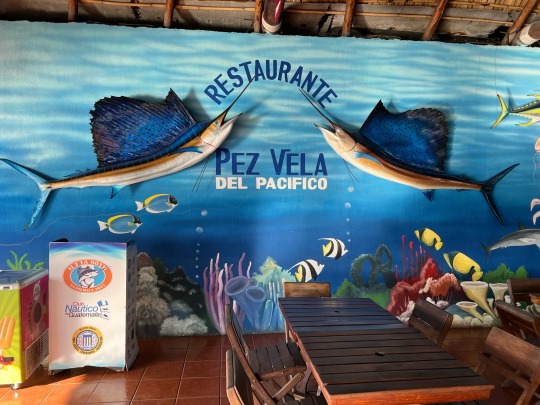
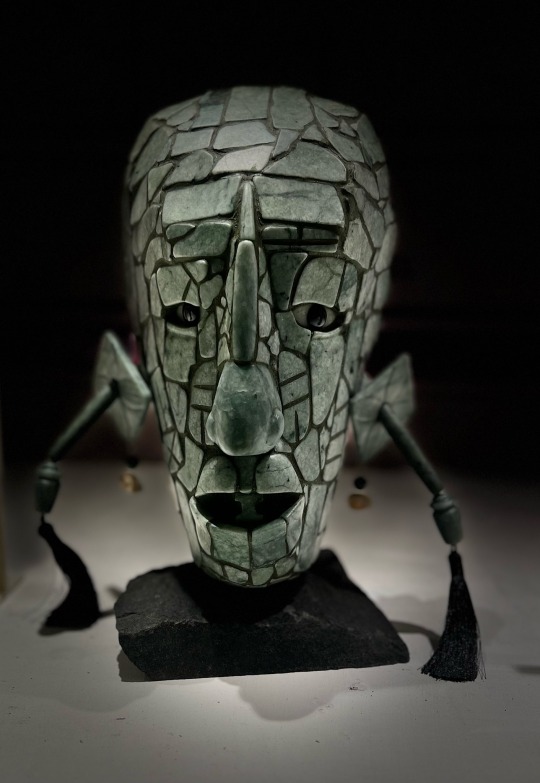
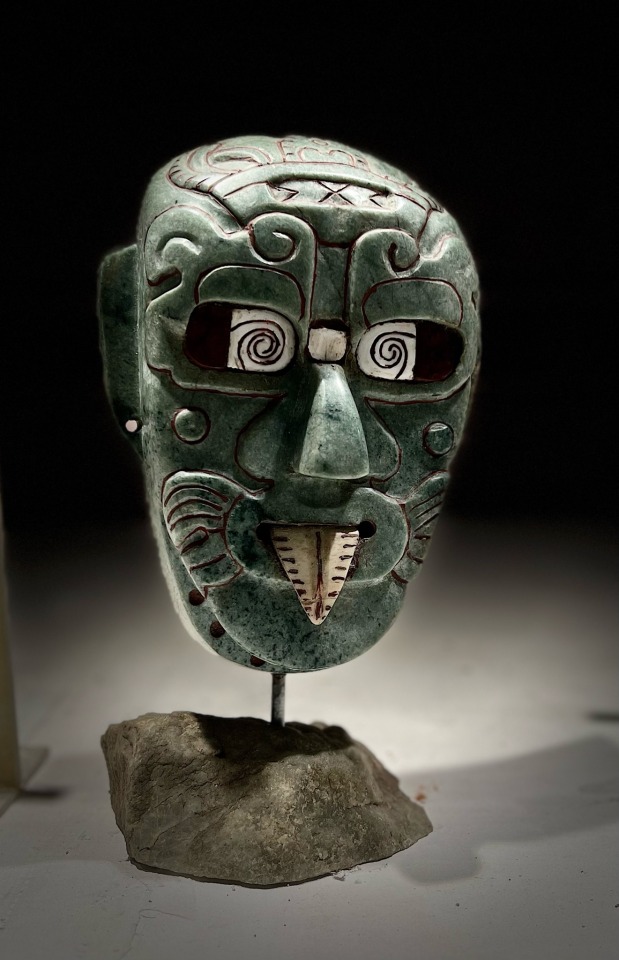
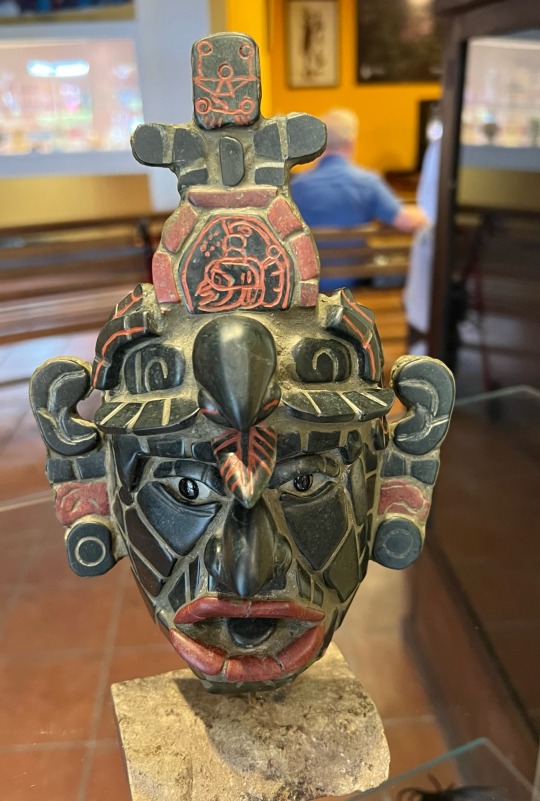

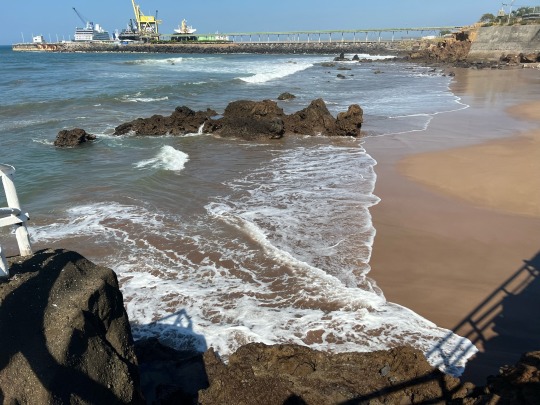
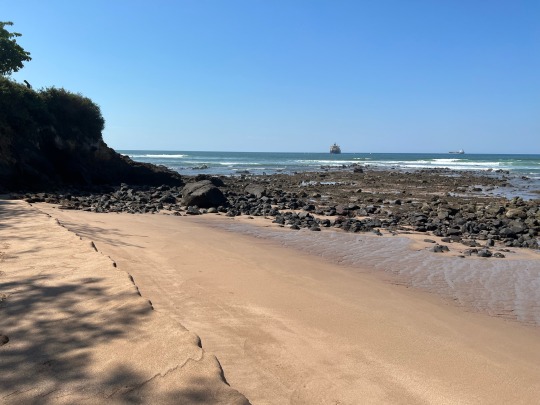
4 notes
·
View notes
Text
During the first week of our intern scholarship in Mexico City, we visited IBERO University. We attended a lecture given by Alberto Irezabal, who told us of the work he had been doing with indigenous coffee bean farmers in the Chiapas region. Alberto had created a project that focused on developing and fostering direct trade relationships with coffee shops and indigenous farming collectives in the northern jungles of Chiapas. This project provided both economic benefits for the farmers, and ecological advantages in relation to the preservation of the jungle’s ecosystem. The farming techniques used by indigenous coffee bean farmers promoted biodiversity within the jungles they harvested in. Therefore, by improving the direct trade relationships between the indigenous farmers and coffee shops, the project was also contributing to the jungle’s ecosystem in being preserved. Alberto spoke of creating economic and environmentally sustainable structures that were designed with the capability of balancing the system. However, he reminded the group that this must be done in a manner that treated the mother rhythm (Gaia / Nature) as the guiding principle for all future structures. Alberto warned that ignoring these natural environmental rhythms could potentially upset the ecological balance of the region, leading to it becoming degraded.
2 notes
·
View notes
Text
Roca Blanca
30 k north of Puerto is Roca Blanca beach, an empty stretch of sand that runs some 5 k south, past a crocodile lagoon, a few stranded fishboats, 1 zillion coconuts, and not much else. At the beach entrance are maybe 10 palapa restaurants, but on a weekday only Jose and Lulus is open. Friendly family run, jose skin dives and spear fishes for the table, while his wife Lulu cooks with her daughter in the board shack kitchen. Beach front palapa, the usual plastic chairs, full shade from a palm thatch roof, and a 180 degree view of the ocean, beach and Roca Blanca one half K offshore( a rugged 2 hectare rock topped with coarse low growing greenery, and deeply coated with white guano, giving it it's name.) There are numerous reefs just breaking the surface offshore, and the corner of the bay is a picture postcard pocket beach turned from the incoming surf, safe for swimming
Access from Puerto is by one of the many vans that do a set run from Puerto to Pinotepa 50 pesos to Cacalote turnoff, maybe a one half hour ride, depending on which cowboy is driving and how often they pass a tractor/coke truck/ motorcyclist/ or anyone fool enough to dawdle. Even with a safe driver, it's nerve wracking, since the oncoming traffic often contains some yahoo who just has to struggle past a truck on a blind curve. Vans don't carry cargo like in Asia, but this one had a 20 kilo bag of powdered milk on the floor,which was topped by a tippy carton of 1oo's of eggs. Hold on at corners!. These vans are how locals shop, visit, and travel. Surprising how many people fit in a van!
At the turnoff the driver kindly pulled well off the road, so we did not have to jump out into traffic. Paid our 50 pesos each, and happy to arrive safely. No taxis in waiting which is unusual, so we walked in. (AM, still cool in the tree shade) i walked with Leslie from Savary island and we chatted about coastal things and island life. Dirt road after Cacalote's cement, coco palm plantations, cattle pasture, and just plain bush. Gordon and Maru, also from Casa Dan, dawdled behind. Effusively greeted by Lulu, we ensconced in the breezy chairs, and had cold drinks. I lucked out and got a green coconut with sweet milk and spoon meat, one of my favorite foods. Wave watching is mezmerizing, and this time was wildly enlivend by a humpback whale one half k offshore who twice breached three quarter out of the water in a vertical leap,falling back with an almighty splash. Huge!
Getting hotter despite some hazy clouds, so time for a swim. I'd packed the night before, but as 2 of my 3 swimsuits were drying on the line i somehow neglected to pack the third one. Duh! However, since the beach was empty i just walked a half K south and skinny dipped. Given that my ass is so white, from a distance it probably looked like a suit anyway. Small surf, easy entry, saw no rays(Leslie did) and it was fun to frolic in the gentle waves, pretending to body surf.
Back at the palapa, everyone broke out books or chatted Nice to socialize, and leslie was able to speak fluently in Spanish, giving Maru a change from the sea of English, She's from Mexico city, and while her English is improving, I know how frustrating it can be to struggle for the appropriate phrase or difficult word.
By noon it was time for lunch, a menu specializing in seafood. The daily special was a filet of a fish whose name I've never heard, cooked with garlic and a bit of rice. Firm white flesh, mild flavour and very fresh. Jose's catch of the day. At 270pesos($20) it was pricey, but more than even i could eat. I still find it odd that Mexicans want to eat rice rather than fresh corn tortillas. Rice does not grow here on the coast. In reality, most of the food consumed here is imported from the interior or down south in Chiapas. The main agricultural crop is peanuts and papayas with mangoes in season. Oddly too, there are no fresh peanuts in the markets, papayas are expensive, and mangoes imported from the Yucatan. Mangoes are flowering, and will overwhelm the local market in April/may. Papayas are exported. Locals grow corn in home fields, or on stripped off hillsides, but it's easier to but corn flour or tortillas from the many torterias in all markets and most neighbourhoods. The mercadoes are full of fruit, all delivered from other places and consequently expensive. in the 3 months I've been here , prices have risen 10%. Still cheap for chicken ($3 pound), and tortillas fresh from the comal ovens are 5 for 10 pesos. Mexico banned GM corn.
Siestas all round after lunch, in hammocks slung along the palapa poles, then more chats, swimming, beach walking, lo-fing. Some how it got to be 3:30, and we called for our bills. Jose kindly drove us out to the highway in his nice four door truck, saving us a hot walk, and a van zoomed along shortly after that had lots of empty seats. There are at least 3 van company operating this route, drivers giving their counterparts a friendly finger wave. Fewer close calls, back to puerto quick, and a combi truck full. Back home by 5 pm. A very satisfactory day, so much so that I'll do it again next week. Having lounged around puerto for 2 months i am motivated to get out to wild spots. No takers for the hot springs walk.I may go alone on that one. likely back to Agua blanca with Pete, Jill ,and Lorraine next week.
2 notes
·
View notes
Text
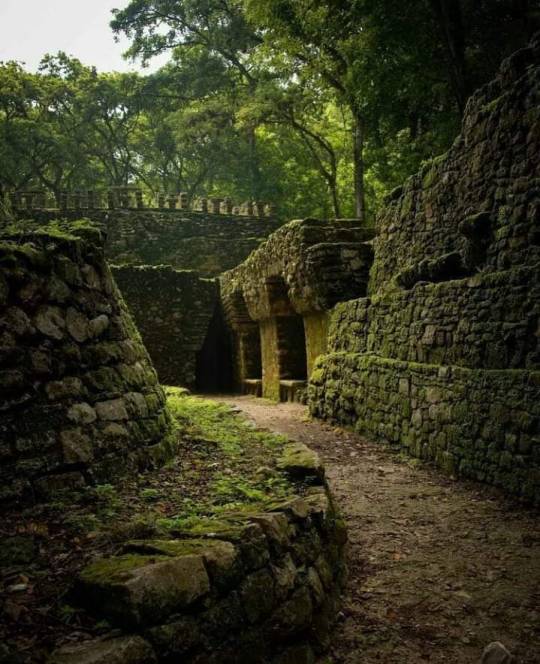
La antigua Ciudad Maya de Yaxchilan, en el corazón de la Selva Lacandona, Chiapas.
1 note
·
View note
Photo

The first stop that Explore Mexico will take is a trip to the Pre-Hispanic City and National Park of Palenque in Chiapas, Mexico. The ancient Mayan city expanded and came to its peak around 400 to 900 AD. It was once ruled by the dynasty of K’inich Janaab ‘Pakal who oversaw the region from 615 to 683 AD. The city had a large presence in the region and ruled with a structured hierarchy typical of other Mayan Societies. The organization consisted of a ruler (K’inich Janaab ‘Pakal was the eleventh of Palenque), nobles, and counselors among the myriad of officials who brought the city to prosperity. Its location in the Yucatan Peninsula, served almost as a geographical gateway to the Mayan empire, providing the setting for long-distance trade. An estimate of its size around 800 AD is believed to be nearly 8,000 people. El Palenque is set in 1780 hectares with an astounding 1,400 buildings have been recorded. To be there in person and look up to these palencano-style buildings is to witness a grand city that once flourished within the Mayan Empire.

Some characteristics of the architecture are unique to the Palenque, the basamentos priamidales were based on the average height of a man. These sections form the base of the temple, the areas which give the pyramid-like structure. The Palenque temples and plazas were constructed of limestone. It was a common stone used to build their structures in the region which was especially plentiful.
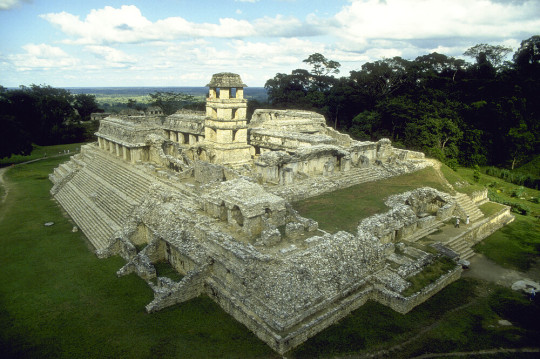
The Palacio or Palace that is pictured above, it is located around the center of the city, it is one of the many sites and temples to visit in the Palenque. There is a temple of La Reina Roja (Red Queen), the temple of La Cruz Foliada ( Foliated Cross), and the temple of La Calavera (The Skull). These are just three of the structures, all of which served a unique purpose and contain inscriptions and depictions singular to the purpose of their construction.
The Palenque’s temples are remarkable for their extensive findings. The tomb of Ixik Tz’aka’ab Ajaw, the ‘Red Queen’ is a notable one. Ixik Tz’aka’ab Ajaw is known as the ‘Red Queen’ due to the dark-red colored mineral found in her tomb. She was the consort of the Ajaw (ruler) Pakal ‘El Grande’. The body of the Red Queen was found adorned with malachite, obsidian, and jade.
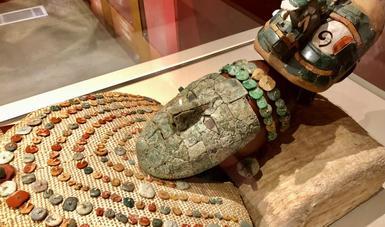

The Palenque was lost amongst the jungle of the Yucatán Peninsula until discovered in 1952 by archeologist Alberto Ruz Lhuillier. In 1987, UNESCO declared the sight an archeological site, and was later declared an archeological monument in 1993 by the Mexican Federal Government. The Palenque is now a protected site and conservation projects are ongoing to maintain this site. It is visited by 600,000 people per year. If I could visit, I would definitely be one of those visitors. It's a place that many should visit, those looking to know more about their culture or to expand their knowledge of Mexican History.
While this blog is exploring the Palenque online, it would be the one I would most like to visit. As seen above, the ancient structures make up a city that focused on expanding and defending the Mayan Empire. The Museum of the Palenque “Alberto Ruz L’Huillier” which first opened in September of 1958 is host to the many artifacts found on site. Some have been returned home, such as the precious stones and artifacts found on the Red Queen. The artifacts and displays give a detailed and unique look into the everyday life of Mayan citizens. It is always better to visit the location in person, to walk the ground the inhabitants did in hundreds of centuries past.
Bibliography:
Stuardo, Rodrigo Liendo and Laura Filloy Nadal. “Arquitectura De Palenque.” Arqueologia Mexicana. Accessed September 2, 2022. www.arqueologiamexicana.mx/mexico-antiguo/arquitectura-de-palenque.
Instituto Nacional De Anthropologia E Historia. Lugares INAH, Museo de Sitio de Palenque “Alberto Ruz L’Huillier”. Accessed September 2, 2022. www.lugares.inah.gob.mx/en/museos-inah/museo/440-museo-de-sitio-de-palenque-alberto-ruz-l-huillier.html.
Instituto Nacional De Anthropologia E Historia. Lugares INAH, Palenque. Accessed September 2, 2022. www.lugares.inah.gob.mx/en/zonas-arqueologicas/zonas/1685-palenque.html.
Instituto Nacional De Anthropologia E Historia. Lugares INAH, Reccorridos. Accessed September 2, 2022. https://www.lugares.inah.gob.mx/en/zonas-arqueologicas/zonas/recorridos/9405-383-recorrido-corto.html
Secretary of Culture of Mexico. Inauguran Pabellón dedicado a la “Reina Roja” de Palenque. March 7, 2021. www.gob.mx/cultura/prensa/inauguran-pabellon-dedicado-a-la-reina-roja-de-palenque.
UNESCO World Heritage Centre. Pre-Hispanic City and National Park of Palenque. Accessed September 2, 2022. https://whc.unesco.org/en/list/411/.
Image Credit List (By Order, First to Last or Top to Bottom):
Geldhof, David. Pre-Hispanic City and National Park of Palenque (Mexico). Gallery of “Pre-Hispanic City and National Park of Palenque”, UNESCO World Heritage Centre. Accessed September 2, 2022. whc.unesco.org/en/documents/109481,
Cowrie, Christa. Templo del Sol. Palenque, Chiapas. Accessed September 2, 2022. www.arqueologiamexicana.mx/mexico-antiguo/arquitectura-de-palenque
Gray, Martin. Panoramic View. Gallery of “Pre-Hispanic City and National Park of Palenque”, UNESCO World Heritage Centre. Accessed September 2, 2022. whc.unesco.org/en/documents/109469.
Instituto Nacional De Anthropologia E Historia. Secretary of Culture of Mexico. March 7, 2021. www.gob.mx/cultura/prensa/inauguran-pabellon-dedicado-a-la-reina-roja-de-palenque.
Gray, Martin. Pre-Hispanic City and National Park of Palenque (Mexico). Gallery of “Pre-Hispanic City and National Park of Palenque”, UNESCO World Heritage Centre. Accessed September 2, 2022. whc.unesco.org/en/documents/109465.
3 notes
·
View notes
Text
SUMMER TO FALL: GRIEF AND GROWTH, TRANSITIONS AND TRIUMPHS.

[tbt to that time we were in vogue lol]
This past summer, we’ve gone through transformation. Rest. Grief. Growth. Abundance and tribulations. But always remembering who we are.
Since our inception, Mariposas Rebeldes has grown to 5 core members, all with very different experiences, backgrounds, and goals … But we have all come together with a common vision to create spaces for Latine folks to build relationships outside of capitalism with each other and with the land. Below, are some deeper-than-an-Instagram-post-reflections on the things we’ve been up to. We hope to intentionally reflect like this every few months. Updates on our land that we are stewarding, which we call Bosque Itzpapalotl [Bos-ke Eets-pa-pa-lotl], will come soon!
Dandelion Fest: Our Anti-capitalist baby
This summer we’ve done a lot, both personally and as a group! But we are super proud that amidst all the chaos, we were able to pull off Dandelion Fest: our claim to fame; our baby; our second year embarking on creating an anti-capitalist space where people can share in the abundance that they and the Earth have to offer, without having the corruption of money involved. We are taking the memories, conversations, and connections that occurred at Dandy Fest with us and applying those lessons to everything we do. Post-Dandy, we created a Cambalache Facebook page, to continue to gift economy in our networks, and encourage people to rely on each other more and on the systems oppressing us less. We also are digging deeper into our anti-capitalist theory + praxis, by taking a class with original Cambalacheres en Chiapas (more of that below), and continuing to bring Cambalache (or free stores) wherever we can, like in Weelaunee forest (more about that below too lol) It brings us so much joy to hear people talk about Dandelion Fest and the memories they made there.
Ultimately, as queer & trans Latine & Indigenous folks just trying to survive in late-stage capitalism, we hope that our work and resistance inspires others to do the same in their communities, or, hell, join us!

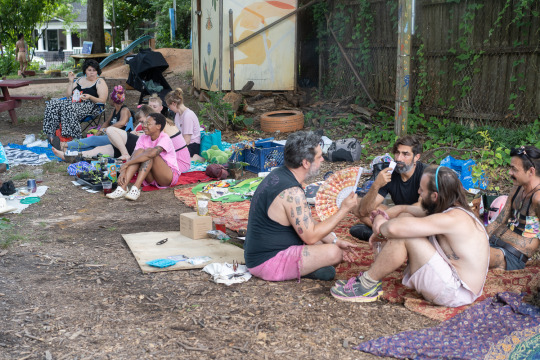
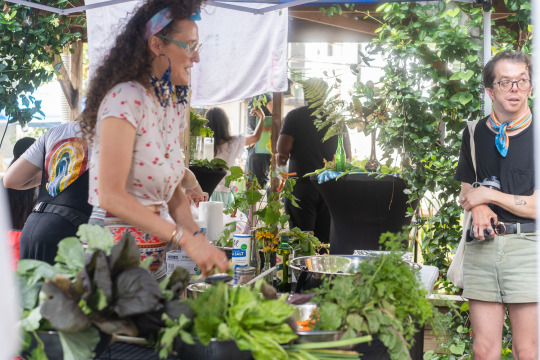
Un Poquito Sobre Nuestro verano (A little bit about us; Our Summer):
Mariposa Jesse (AKA Yesika Esmeralda Amanita), recently left her role as the director of the Trans Housing Coalition, after two years. She’s been moving through that transition, trying to find joy, shifting to doing more autonomous organizing to Stop Cop City and with Mariposas, learning to love herself more and more. Abundia has continued to Mariposiar back and forth from Tennessee and Atlanta, like the true Mariposa she is. Back and forth she is building bridges and weaving webs of abundance between Nashville, Middle TN and Atlanta. She also visited her Muscogee ceremonial grounds for the first time since the pandemic. Also, she finally got all her teeth work done! Edricito had been dealing with health and relationship changes and transitions, trying to survive the queer non-profit industrial complex, but remembering to find joy in the little things: like painting and poetry. Israel has started a new job with Community food scapes and has remained our grounding Mariposa for our group, PJ has been surviving the food service industry as a trans person while still holding it down with the Mariposas--and both Isa & PJ have held it down with our land project and continued to learn to steward and build up the infrastructure for our land and building relationships in the South with other queer-indigenous led land projects.

Cambalache: Learning from Indigenous Anti-Capitalist Praxis:
One of the many things we are doing is taking a class with the El Cambalache San Cristobal Project. The classes are hosted twice a year and teach folks all around the world about their anti-capitalist Cambalache project in Chiapas, México. We are excited and grateful to be learning from badass Indigenous organizers who are doing amazing work in their native countries to reclaim land, resources, and power. In Chiapas, there is even an autonomous system for their water that isn’t reliant on the state. We are excited to continue to expand our anti-capitalist theory + praxis by applying what we learn while continuing to heal from the effects of capitalism and colonialism that make us disconnected from the land and each other. The Cambalacheras (they are a 100% women-led project) are currently battling being evicted from their space. We will be working to uplift their efforts in a more formal way, but for now, donate to their GoFundme.
Mariposas Defend Weelaunee:
Aside from the land, we’ve been involved in the struggle to defend the Weelaunee forest (aka South River forest) and stop Cop City in varying capacities. Most recently, we put out a Cambalache Free Store during the last Week of Action (WoA) in late July, taking what we learned from the Dandelion fest, our Cambalache class, and offering it to the movement! What began as a modest free store for the kick off celebration of the WoA, turned into a grounding piece of the week of action. People who both live in (self-described forest defenders & tree sitters) and those who were visiting for the WoA visited the tent to have a respite from the forest, to get or donate a new outfit, literature, and many other things. During the kick off event, people traded Reishi mushrooms and herbs for seeds with us, we met new people and re-connected with people we’ve met over the years, and became part of a collective effort to reclaim the Weelaunee park and forest from the hands of the state. We believe we will collectively stop their plan to further desecrate the land by turning it into a militarized police zone. The goal is to reclaim the space for the people—all people—but, particularly the Black and brown folks who live in the surrounding neighborhoods. No one should have to raise their children with the sounds of gunshots from the Police shooting range nearby disrupting sleep.
Mariposas Return to the Gayborhood
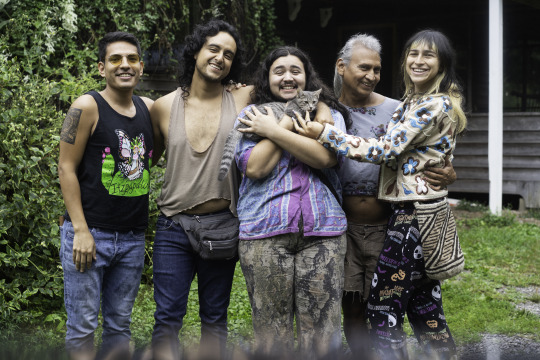
Virgo season was generative for us Mariposas, and we have (mostly) moved through Libra season with grace. We are sowing the seeds for the following year, and solidifying traditions that we’ve been cooking up together for now two and a half years. In September, we went back to the “Gayborhood”, a communal queer & trans community that lives on many plots of land on Short Mountain. The Gayborhood has hosted the Mariposas for two “work” retreats now. The first time was in 2020, when the pandemic first started and we had just come together. It was a transformative experience then and now. We stayed in Breathwood, a beautiful home with more infrastructure than most of the housing on the mountain and in the Gayborhood. Breathwood was first owned by a Faerie as their private residence. Abundia had connections to the owners who opened the space to us.
This year, we returned to some beautiful changes. Breathwood is no longer owned by a single affluent Faerie, but instead has moved into a collective land trust and communal stewardship by the Queer & Trans folks who live on the mountain. Pre-colonization, the lands of the Gayborhood were used as communal hunting grounds for several tribes (namely the Yuchi, Cherokee, Musckogee). Breathwood is a small step towards moving the land back into communal ownership and stewardship, something that many on the mountain have also done for the last 40 years. We also got to rest, rejoice, and scheme for the upcoming year of rebeldías. Also on the mountain, we celebrated our co-fundadora Abundia’s birthday, made tortillas and arepas from scratch (with nixtamal and a molinito) nursed a baby squirrel back to life, and danced under the Pisces harvest moon - reveling in the abundance that this summer has brought us. We hope to continue to learn from the communities being built on this magical mountain….
A belated birthday Shout-out to our founding Mariposa, Abundia!
Didn’t wish our Abundia a happy birthday? You still can! By sending her some belated birthday-coin. Abundia has been the glue, the water to our masa, the fire beneath the Mariposas since she and Israel started having the conversations about abundance, food sovereignty, and connecting to our cultura, back in early (pre-COVID) 2020, during their trip to Tenochtitlan [tuh·nowch·teet·laan] or so-called Mexico City.
Abundia has had a transformative year. She has split her time between Springfield, TN and Atlanta, the latter where she has worked tirelessly para la comunidad. She is leading the work to continue including Muscogee folks in the efforts to Stop Cop City and Defend Weelaunee Forest. She also stays weaving, expanding, and worshiping a southern web of abundance. She is helping open spaces in the South focused on Black, Indigenous, and LGBTQ people connecting holistically with one another and nature. In particular, she works with the Chinkapin Land Collective, in Woodbury, Tennessee, is board member for Breathwood, and has participated in getting to know other collectives such as the Passion Vine Collective in south Florida.
Abundia does most of this work without pay, and without enough funds for gas and phone bills. We need to compensate our Black, Indigenous, Queer + Trans elders as much as possible for their labor! To pay Abundia for her labor, see her payment info in the graphic below:
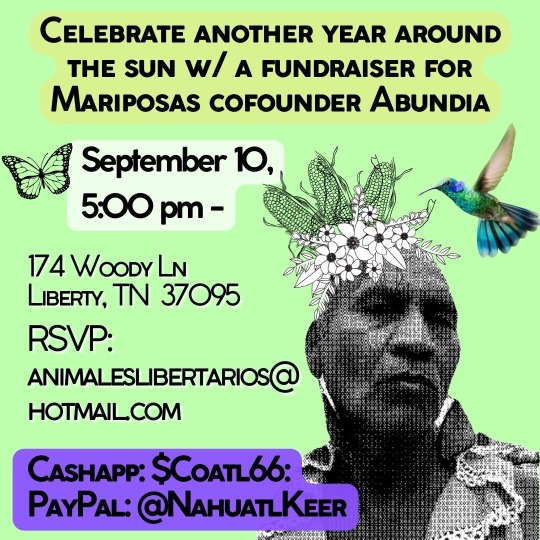
If you read this far, you are a real ass Mariposa. As for us? We’re older, wiser, hotter, and trans-er, two+ years into a pandemic and into being in relationship with each other and all of the community and land we’ve touched in so-called Atlanta.
#landback#indigenous#latinx#hispanic heritage month#food forest#forest#foraging#food#atlanta#muscogee#summer#fall 2022#community#queer community#lgbtqia#lgbt#lgbtq community#queer history#queer love#trans#gay
4 notes
·
View notes
Note
bestie, i got a question for you. If money and time werent an issue, what 3 places would you love to visit (and why?)
I escaped the mental exhaustion old folks home to bring you this message! Thank you for asking such a fun question! I love you *muwah*
I would love to visit Tokyo, Japan! And Hokkaido. I have friends there who I haven't seen since highschool and I would love to see them.
I also would love to go to Italy. My mother was adopted from there. I recently found out that if you can prove your grandparents were Italian then you can use that documentation to become a citizen. I am amazed by that and need to look further into it bc I am definitely interested in doing that if it's true. I'm particularly interested in southern Italy, the nature is so beautiful and I love beaches.
HmmMmMm it's hard to pick a third choice, it's a toss up between Mexico and Luxembourg. I want to go to Chiapas specifically because the nature is so stunningly gorgeous there! Luxembourg interests me because of the chill vibe everyone seems to have there in travel videos I've watched. And also it's nestled between France, Belgium, and Germany so I feel it would be a fun melting pot to visit.
4 notes
·
View notes